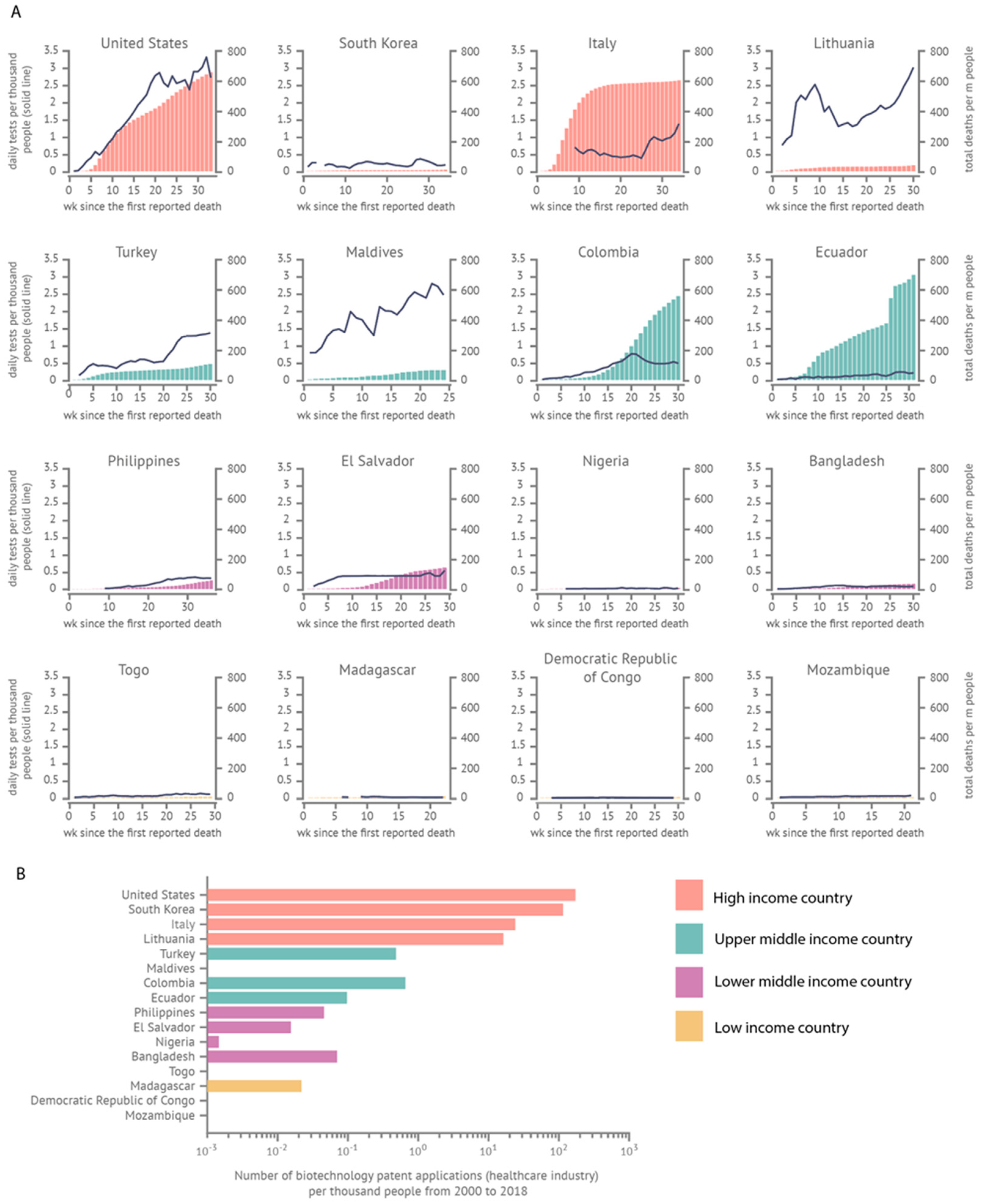The Shortcomings of COVID-19 Testing in Ecuador: Time to Incentivize Research and Innovation
Abstract
:Author Contributions
Funding
Institutional Review Board Statement
Informed Consent Statement
Data Availability Statement
Conflicts of Interest
References
- Karlinsky, A.; Kobak, D. Tracking excess mortality across countries during the COVID-19 pandemic with the World Mortality Dataset. Elife 2021, 10, e69336. [Google Scholar] [CrossRef] [PubMed]
- Hallo, A.; Rojas, A.; Hallo, C. Perspective from Ecuador, the second country with more confirmed cases of coronavirus disease 2019 in South America: A review. Cureus 2020, 12, e7452. [Google Scholar] [CrossRef] [PubMed] [Green Version]
- Shuchman, M. Low-and middle-income countries face up to COVID-19. Nat. Med. 2020, 26, 986–988. [Google Scholar] [CrossRef] [PubMed]
- Rochmyaningsih, D. The developing world needs more than numbers. Nature 2017, 542, 7. [Google Scholar] [CrossRef] [PubMed] [Green Version]
- El Mercurio. Available online: ww2.elmercurio.com.ec (accessed on 7 April 2021).
- Simbana-Rivera, K.; Gomez-Barreno, L.; Guerrero, J.; Simbana-Guaycha, F.; Fernandez, R.; Lopez-Cortes, A.; Lister, A.; Ortiz-Prado, E. Interim Analysis of Pandemic Coronavirus Disease 2019 (COVID-19) and the SARS-CoV-2 Virus in Latin America and the Caribbean: Morbidity, Mortality and Molecular Testing Trends in the Region. medRxiv 2020. Available online: https://www.medrxiv.org/content/10.1101/2020.04.25.20079863v1 (accessed on 4 April 2021).
- Portal de Noticias USFQ. Available online: noticias.usfq.edu.ec (accessed on 7 April 2021).
- Prado-Vivar, B.; Becerra-Wong, M.; Guadalupe, J.J.; Márquez, S.; Gutierrez, B.; Rojas-Silva, P.; Grunauer, M.; Trueba, G.; Barragán, V.; Cárdenas, P. A case of SARS-CoV-2 reinfection in Ecuador. Lancet Infect. Dis. 2021, 6, e142. [Google Scholar] [CrossRef]
- Singer, P.A.; Daar, A.S. Harnessing genomics and biotechnology to improve global health equity. Science 2001, 294, 87–89. [Google Scholar] [CrossRef] [PubMed]
- Sheridan, C. COVID-19 spurs wave of innovative diagnostics. Nat. Biotechnol. 2020, 38, 769–772. [Google Scholar] [CrossRef] [PubMed]
- Grenfell, B.T.; Pybus, O.G.; Gog, J.R.; Wood, J.L.; Daly, J.M.; Mumford, J.A.; Holmes, E.C. Unifying the epidemiological and evolutionary dynamics of pathogens. Science 2004, 303, 327–332. [Google Scholar] [CrossRef] [PubMed] [Green Version]
- Saad-Roy, C.M.; Morris, S.E.; Metcalf, C.J.E.; Mina, M.J.; Baker, R.E.; Farrar, J.; Holmes, E.C.; Pybus, O.G.; Graham, A.L.; Levin, S.A.; et al. Epidemiological and evolutionary considerations of SARS-CoV-2 vaccine dosing regimes. Science 2021, 372, 363–370. [Google Scholar] [CrossRef] [PubMed]
- Callaway, E. Beyond Omicron: What’s next for COVID’s viral evolution. Nature 2021, 600, 204–207. [Google Scholar] [CrossRef] [PubMed]
- Carrazco-Montalvo, A.; Armendáriz-Castillo, I.; Tello, C.L.; Morales, D.; Armas-Gonzalez, R.; Guizado-Herrera, D.; León-Sosa, A.; Ramos-Sarmiento, D.; Fuertes, B.; Patino, L.; et al. First detection of SARS-CoV-2 variant B. 1.1. 529 (Omicron) in Ecuador. New Microbes New Infect. 2022, 7, 100951. [Google Scholar] [CrossRef] [PubMed]
- Maher, M.C.; Bartha, I.; Weaver, S.; Di Iulio, J.; Ferri, E.; Soriaga, L.; Lempp, F.A.; Hie, B.L.; Bryson, B.; Berger, B.; et al. Predicting the mutational drivers of future SARS-CoV-2 variants of concern. Sci. Transl. Med. 2021, eabk3445. [Google Scholar] [CrossRef]

Publisher’s Note: MDPI stays neutral with regard to jurisdictional claims in published maps and institutional affiliations. |
© 2022 by the authors. Licensee MDPI, Basel, Switzerland. This article is an open access article distributed under the terms and conditions of the Creative Commons Attribution (CC BY) license (https://creativecommons.org/licenses/by/4.0/).
Share and Cite
Chalen, I.; Cobo, M.M.; Gutierrez, B.; Carrazco-Montalvo, A.; Ponce, P.; Cisneros-Heredia, D.F. The Shortcomings of COVID-19 Testing in Ecuador: Time to Incentivize Research and Innovation. Life 2022, 12, 325. https://doi.org/10.3390/life12030325
Chalen I, Cobo MM, Gutierrez B, Carrazco-Montalvo A, Ponce P, Cisneros-Heredia DF. The Shortcomings of COVID-19 Testing in Ecuador: Time to Incentivize Research and Innovation. Life. 2022; 12(3):325. https://doi.org/10.3390/life12030325
Chicago/Turabian StyleChalen, Izan, María Mercedes Cobo, Bernardo Gutierrez, Andrés Carrazco-Montalvo, Patricio Ponce, and Diego F. Cisneros-Heredia. 2022. "The Shortcomings of COVID-19 Testing in Ecuador: Time to Incentivize Research and Innovation" Life 12, no. 3: 325. https://doi.org/10.3390/life12030325
APA StyleChalen, I., Cobo, M. M., Gutierrez, B., Carrazco-Montalvo, A., Ponce, P., & Cisneros-Heredia, D. F. (2022). The Shortcomings of COVID-19 Testing in Ecuador: Time to Incentivize Research and Innovation. Life, 12(3), 325. https://doi.org/10.3390/life12030325






